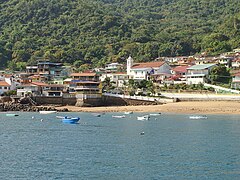Taboga Island
Coordinates: 8°47′0″N 79°33′0″W / 8.78333°N 79.55000°W
Native name: Isla Taboga Nickname: Island of Flowers | |
|---|---|
 | |
 Taboga Island | |
| Geography | |
| Location | Gulf of Panama |
| Coordinates | 8°47′0″N 79°33′0″W / 8.78333°N 79.55000°W |
| Area | 12.1 km2 (4.7 sq mi) |
| Administration | |
| Province | Panamá |
| District | Taboga |
| Demographics | |
| Population | 1.629 |
| Pop. density | 134.6/km2 (348.6/sq mi) |

Taboga Island (Spanish: Isla Taboga), also known as the "Island of Flowers", is a volcanic island in the Gulf of Panama. It is a tourist destination, about 20 km from Panama City, Panama.
History[]
The island was discovered in the 16th century and was originally named Isla de San Pedro by the Spanish explorer Vasco Núñez de Balboa.[1] Its current name derives from an Indian word aboga ("many fish"). The island's first settlers were Indian slaves from Venezuela and Nicaragua. The small town of was founded in 1524 by Hernando de Luque, dean of the Panama cathedral. The town church of the same name is claimed to be the second-oldest church in the hemisphere. Rose of Lima (1586–1617), the first Catholic saint of the Americas, may have been born on the island.[2] French painter Paul Gauguin visited the island in 1887.[3] Paul Gauguin in Taboga
Having worked for the first (French) attempt to dig a canal from the Caribbean Sea to the Pacific, attempt in which 22000 workers lost their life, French painter Paul Gauguin, taking ill, was sent for treatment in Taboga Island; he then returned to France, with a stopover in Martinique; then left for the Marquesas and meeting his Destiny. His stay in Taboga is marked by an engraved plate on the island's main beach.[4]
Geography[]
At low tide, the northern end of the island is joined by a sand bar to the small island of El Morro, and the southeastern end is 270 metres (886 feet) from the neighboring . The island has a tropical rain forest climate (Af), with average daytime temperatures of 83 °F (28 °C). It is famous for its beautiful beaches, clear waters, soft sands, and wildlife refuge.
Tourism[]
Tourism is the major economic activity on the island, although fishing and agriculture are also practiced. The island has become a popular touristic attraction due to its beautiful natural areas and its proximity to Panama City.[5] Daily ferries link the city to the island, most of them departing from the Amador Causeway.
Aside from beaches, the island has trails for hiking to its highest points, including Cerro Vigía and Cerro de la Cruz. The latter is a hill located south of the town, topped with a huge cross.[6] many activities are available such as: Boat tours for fishing, whale watching, snorkeling, mountain tours and sightseeing are available, as well as walking and nature tours.
Taboga Island has small hotels and restaurants Calaloo Beach Fishbar & Grill on Playa Honda just 2 minutes from the pier, Agua Sol Villa, located on the water with a private beach entry from the hotels ocean deck; palm beach hotel, B and B Hotel Cerrito Tropical and Restaurant; Mundi's; Hotel Vereda Tropical, Taboga Palace, the espectacular Villa Caprichosa Boutique Hotel (@villa_caprichosa) and La Dolce Vita Restaurant by the famous American-Italian designer Diane Burn.
Tours such as mountain tours, historical walking tours, whale watching, boat tours, bird watching,snorkelin,fishing, paddleboarding, gear rental, beach locker rentals and daypasses can be organized through Taboga Tour Center.
Taboga also has the famous Cementerio do Taboga (Cemetery of Taboga) it is the oldest cemetery on the Island and is full of rich history and decorative headstones and graves.
References[]
- ^ "Some History of Isla Taboga". Retrieved 2011-03-13.
- ^ "Taboga History". Fundación Isla de Taboga. Archived from the original on 2011-07-13. Retrieved 2011-03-13.
- ^ "Taboga's tribute to Paul Gauguin". The Panama News. Archived from the original on 2011-07-17. Retrieved 2011-03-13.
- ^ <https://theculturetrip.com/central-america/panama/articles/gauguin-in-panama-a-forgotten-journey/>
- ^ "Un día de carnaval en Taboga" (in Spanish). La Prensa (Panamá). Retrieved 2011-03-13.
- ^ "Places to Explore: Isla Taboga". Fodor's Travel Guides. Retrieved 2011-03-13.
External links[]
- Pacific islands of Panama
- Gulf of Panama
- Panamá Province
